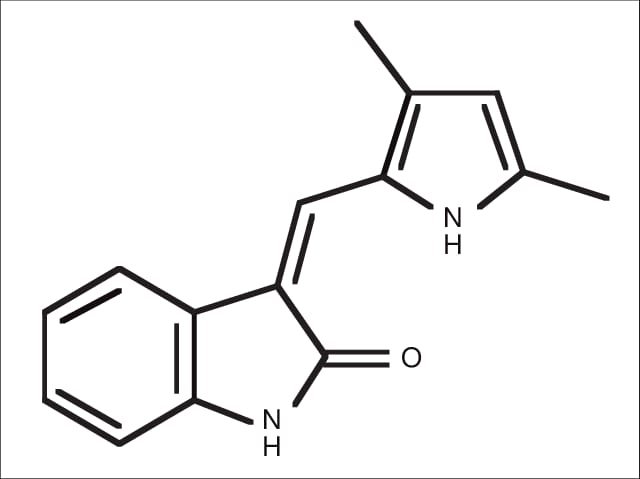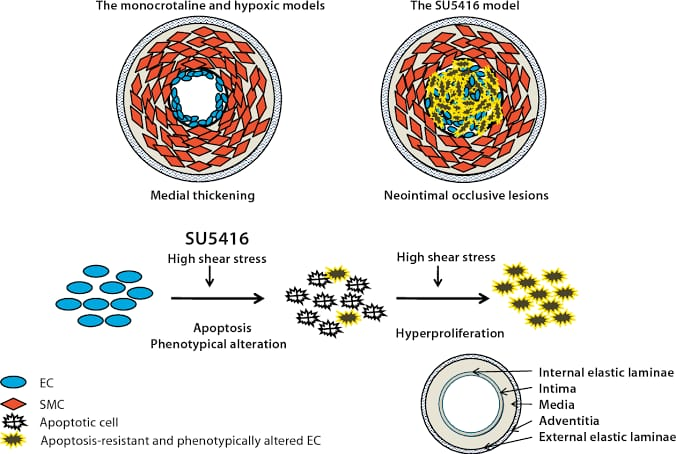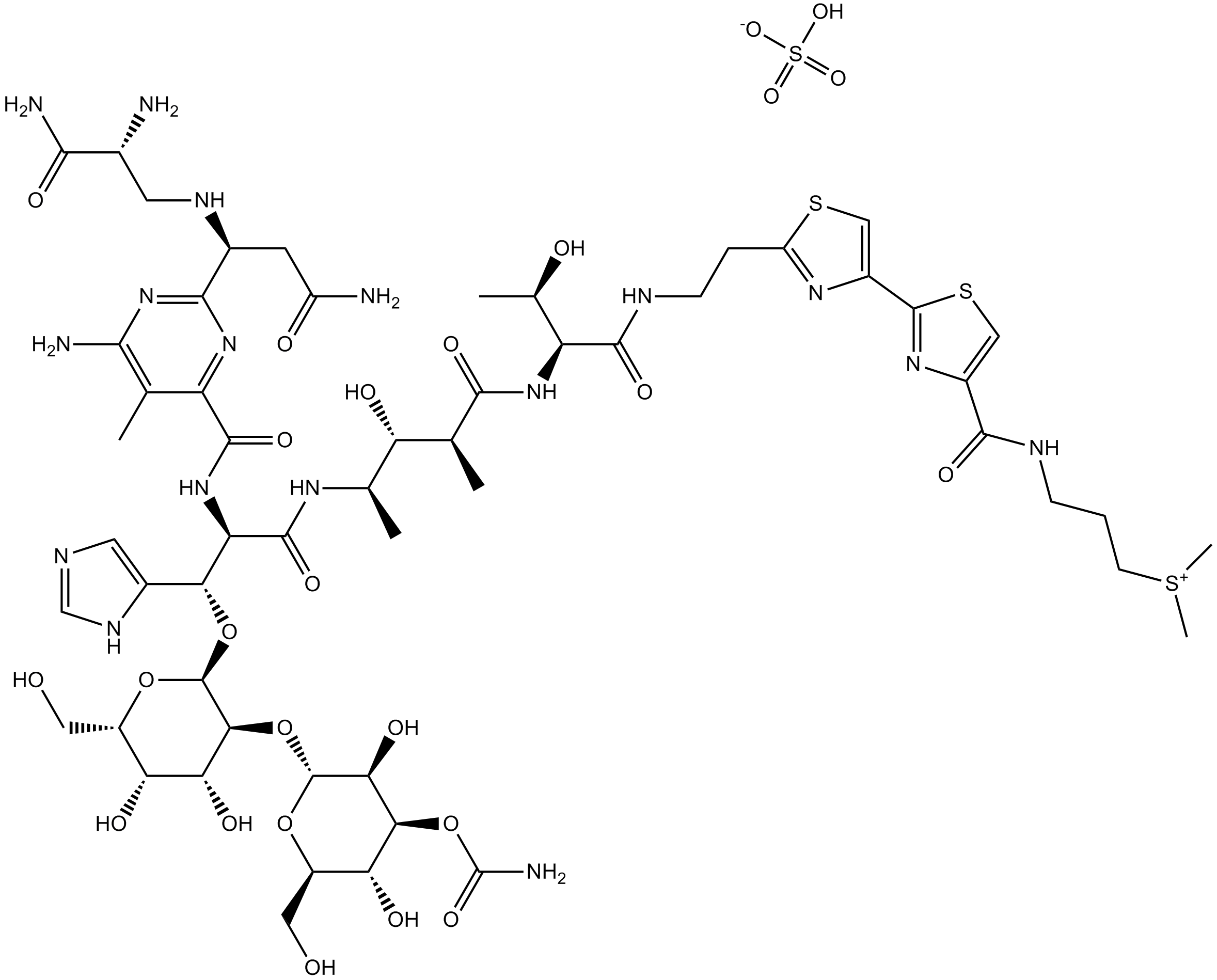SU5416
SU5416 is a small, protein bounded, lipophilic in nature molecule, that has the potential to act as an inhibitor for the receptor tyrosine kinase of the vascular endothelial growth factor receptor 1 and 2. With relation to the kinase domain, it can also inhibit the adenosine triphosphate as a competitive inhibitor. Different in-vivo and in-vitro animal model studies explained its inhibitory function for the proliferation of endothelial cells. These studies also explained that, although SU5416 does not have cytotoxic effects, but it can inhibit the growth of cancer tissue or cell in different xenograft models like prostate, fibrosarcoma, glioma, breast, colorectal cancer, etc. But its action is dose-dependent. Especially in the xenografts of colorectal cancer, SU5416 can inhibit the proliferation of cancer cells, microvessel formation, and metastasis of tumors. Furthermore, along with the inhibition of VEGF-2, it also has the potential to inhibit the other 2 families of tyrosine kinase. These include C-kit and FLT3 which are expressed in acute myeloid leukemia. This C-kit ligand binding leads to the initiation of autophosphorylation and the phosphorylation of different substrates within the cell through SCF. Further, this SCF inhibits the process of apoptosis in AML blasts. Studies found that this SU5416 can inhibit the SCF-induced autophosphorylation in MO7E and AML human cell lines along with the induction of apoptosis and inhibition of cellular proliferation. It is also mentioned that FLT3 is associated with hematopoietic progenitors. Any dysregulation in the FST3 pathway leads to the incidence of various kinds of myeloproliferative diseases. ITD mutation of FST3 is the most common type of defect in AML patients. As we know that SU5416 can inhibit the FST3 pathway, therefore it can inhibit the VEGFR-2, and target angiogenesis in bone marrow in AML patients.

Figure 1:: Structure of SU5416
As we have discussed earlier that SU5416 can be extensively used to inhibit the growth of various cancer cells by inhibiting the VEGF-2. VEGF-2 plays a key role in the progression of the tumor through the formation of new blood vessels. That’s why it can be used as a therapeutic drug for the treatment purpose of colorectal cancer. Colorectal cancer is the second major cause of cancer- death in the United States. In past, it is suggested that chemoradiotherapy is the best approach for the treatment of colorectal cancer than the alone use of either chemotherapy or radiotherapy. One of the studies revealed that a molecule that is radiosensitizer and can inhibit angiogenesis can be used as a therapeutic drug for its recovery. They started the use of SU5416 as a radiosensitizer because it can inhibit VEGF-2. In this study, researchers use two specific cell lines for colorectal cancer, HT-29 & HCT116. In an in-vitro study, they treated these cell lines with SU5416 along with the control group, and treatment of SU5416 along with radiotherapy. After performing the flow cytometry analysis along with the immunohistochemistry and invasion assay, they concluded that the use of SU5416 along with the combination of radiotherapy gives satisfactory results of successful treatment of colorectal cancer than alone radio or chemotherapy due to its anti-metastatic and anti-angiogenic properties.
As we have discussed earlier that abnormal angiogenesis is one of the key factors for the development of various kinds of diseases particularly tumors. This angiogenesis may also leads to the progression/development of pulmonary fibrosis (idiopathic). The main reason related to this abnormal angiogenesis is VEGF-2 which acts as an angiogenic factor for idiopathic pulmonary fibrosis. In this study, researchers induce pulmonary fibrosis in mice via the use of Bleomycin. After that researchers infused the SU5416 intraperitoneally at specific intervals. By measuring the angiogenesis and the & inflammatory response from bleomycin-induced pulmonary fibrosis in mice, they found that this bleomycin increases the number of microvessels via increased expression of Flk-1. Upon treatment with SU5416, there will be the inhibition of deposition of collagen tissue along with the activation of TGF-β1 in Bleomycin-induced fibrosis in the lungs of mice. This SU5416 also reduces the formation of microvessels by inhibiting the Flk-1. They also stated that this SU5416 can also reduce the activity of LDH and IL-13 expression in pulmonary tissues. Due to this reason, it can be used as a therapeutic Drug for the attenuation of pulmonary fibrosis.
From all these above-mentioned studies, it is clear that vascular endothelial growth factor is the important one for the survivability of endothelial cells because of its anti-apoptotic action. Different clinical phase studies explain that the use of SU5416 can be the best option for the development of cancer therapies. It is because, it can be easily tolerated by patients which are in a terminal stage of cancer. Although different cancer cells have different sensitivity for SU5416. But the major factor, which arises for SU5416, is its use in the development of models for angioproliferative pulmonary hypertension. This is because it helps to understand the development of PAH through the inhibition of VEGF. This study also stated that SU5416 along with chronic hypoxia can cause neointimal changes along with the PAH in rats. While the other classical models are not able to cause intimal changes in the peripheral arteries of the lungs. They stated that the neointimal changes resemble the plexiform lesions which are not apparent in the case of classical models. Although the exact mechanism regarding the action of SU5416 is still unclear, but it is suggested that due to the blockage of the signaling pathway for VEGF, there will be an increase in apoptosis. This condition then flavors the endothelial cells to be apoptosis-resistant. After that, the endothelial cells undergo hyperproliferation because of the increase in the growth potential. These endothelial hyperproliferative cells resemble plexiform lesions in lung tissue. That’s how SU5416 would be able to generate models of PAH.

Figure 2:: Development of models for angioproliferative pulmonary hypertension via SU5416.
In the end, it is concluded that SU5416 is a synthetic compound that is used to inhibit the tyrosine kinase receptors for the treatment of various kinds of diseases and human cancers. One of the in-vitro studies suggested that it can inhibit the VEGF-dependent mitogenesis of human tumor cells without affecting the growth of a variety of cancer cells. Apart from this, if it has given a chance to show systemic action, it can inhibit the growth of subcutaneous cancer growth. This statement explains its anti-tumor characteristic because of the white tumor mass resection after its injection














Comments